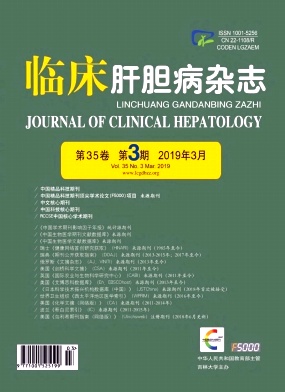|
[1] ASHWANI KS, PATRICK SK, GREGORY JG, et al. Alcoholichepatitis:Current challenges and future directions[J]. ClinGastroenterol Hepatol, 2014, 12 (4) :555-564.
|
|
[2] PAUL G, YAN Z. Biogenesis of mammalian microRNAs:Aglobal view[J]. Genomics Proteomics Bioinformatics, 2012, 10 (5) :239-245.
|
|
[3] ZHAO XM, LIU KQ, ZHU G, et al. Identifying cancer-relatedmicroRNAs based on gene expression data[J]. Bioinformat-ics, 2015, 31 (8) :1226-1234.
|
|
[4] GENG YJ, LI SD, LIU ZZ, et al. Inhibitory effect of microRNA-149-5p in the proliferation and migration of HepG2 and Be1-7402 hepatoma cells[J]. J Clin Hepatol, 2017, 33 (6) :1126-1130. (in Chinese) 耿亚军, 李树栋, 刘中政, 等. microRNA-149-5p过表达对肝癌细胞HepG2和Bel-7402增殖及迁移的抑制作用[J].临床肝胆病杂志, 2017, 33 (6) :1126-1130.
|
|
[5] BECKER S, FLORIAN A, PATRASCU A, et al. Identification ofcardiomyopathy associated circulating miRNA biomarkers inpatients with muscular dystrophy using a complementary car-diovascular magnetic resonance and plasma profiling ap-proach[J]. J Cardiovasc Magn Reson, 2016, 18 (1) :244.
|
|
[6] AGARWAL V, BELL GW, NAM JW, et al. Predicting effectivemicroRNA target sites in mammalian mRNAs[J]. e Life, 2015, 4:e05005.
|
|
[7] RECZKO M, MARAGKAKIS M, ALEXIOU P, et al. FunctionalmicroRNA targets in protein coding sequences[J]. Bioinfor-matics, 2012, 28 (6) :771-776.
|
|
[8] WONG N, WANG XW. miRDB:An online resource for microR-NA target prediction and functional annotations[J]. NucleicAcids Res, 2015, 43 (D1) :d146-d152.
|
|
[9] AZRA K, DOMINIC G, MATTHEW NP, et al. Combinatorial mi-croRNA target predictions[J]. Nat Genet, 2005, 37:495-500.
|
|
[10] DWEEP H, STICHT C, PANDEY P, et al. miRWalk-data-base:Prediction of possible miRNA binding sites by"walk-ing"the genes of 3 genome[J]. J Biomed Inform, 2011, 44 (5) :839-847.
|
|
[11] DWEEP H, GRETZ N. miRWalk2. 0:A comprehensive atlas ofmicroRNA-target interactions[J]. Nat Methods, 2015, 12 (8) :697-697.
|
|
[12] GLYNN D, SHERMAN BT, HOSACK DA, et al. DAVID:Data-base for annotation, visualization, and integrated discovery[J]. Genom Biol, 2003, 4 (5) :p3.
|
|
[13] BARRETT T, SUZEK TO, TROUP DB, et al. NCBI GEO:Min-ing millions of expression profiles—database and tools[J].Nucleic Acids Res, 2005, 33:d562-d566.
|
|
[14] AFFO S, DOMINGUEZ M, LOZANO JJ, et al. Transcriptomeanalysis identifies TNF superfamily receptors as potential thera-peutic targets in alcoholic hepatitis[J]. Gut, 2013, 62 (3) :452-460.
|
|
[15] BLAYA D, COLL M, RODRIGO-TORRES D, et al. IntegrativemicroRNA profiling in alcoholic hepatitis reveals a role for mi-croRNA-182 in liver injury and inflammation[J]. Gut, 2016, 65 (9) :1535-1545.
|
|
[16] SMYTH GK. Linear models and empirical Bayes methods forassessing differential expression in microarray experiments[J]. Stat Appl Genet Mol Biol, 2004, 3 (3) :Article3.
|
|
[17] RITCHIE ME, PHIPSON B, WU D, et al. Limma powers differ-ential expression analyses for RNA-sequencing and microar-ray studies[J]. Nucleic Acids Res, 2015, 43 (7) :e47.
|
|
[18] WANG J, CHU ESH, CHEN HY, et al. microRNA-29b pre-vents liver fibrosis by attenuating hepatic stellate cell activationand inducing apoptosis through targeting PI3K/AKT pathway[J]. Oncotarget, 2015, 6 (9) :7325-7338.
|
|
[19] MATHURIN P, BEUZSIN F, LOUVET A, et al. Fibrosis pro-gression occurs in a subgroup of heavy drinkers with typicalhistological features[J]. Aliment Pharmacol Ther, 2007, 25 (9) :1047-1054.
|
|
[20] MCKNIGHT-EILY LR, HENLEY SJ, GREEN PP, et al. Alco-hol screening and brief intervention:A potential role in cancerprevention for young adults[J]. Am J Prev Med, 2017, 53 (3S1) :s55-s62.
|
|
[21] SCHEIDELER JK, KLEIN WMP. Awareness of the link betweenalcohol consumption and cancer across the world:A review[J]. Cancer Epidemiol Biomarkers Prev, 2018, 27 (4) :429-437.
|
|
[22] GU S, NGUYEN BN, RAO S, et al. Alcohol, stem cells andcancer[J]. Genes Cancer, 2017, 8 (9-10) :695-700.
|
|
[23] PIANO MR. Alcohol's effects on the cardiovascular system[J]. Alcohol Res, 2017, 38 (2) :219-241.
|
|
[24] GOEL S, SHARMA A, GARG A. Effect of alcohol consumption oncardiovascular health[J]. Curr Cardiol Rep, 2018, 20 (4) :19.
|
|
[25] REHM J, ROERECKE M. Cardiovascular effects of alcohol con-sumption[J]. Trends Cardiovasc Med, 2017, 27 (8) :534-538.
|
|
[26] GHIGO A, LAFFARGUE M, LI M, et al. PI3K and calcium sig-naling in cardiovascular disease[J]. Circ Res, 2017, 121 (3) :282-292.
|
|
[27] GHIGO A, MORELLO F, PERINO A, et al. Therapeutic appli-cations of PI3K inhibitors in cardiovascular diseases[J]. Fu-ture Med Chem, 2013, 5 (4) :479-492.
|







 DownLoad:
DownLoad: